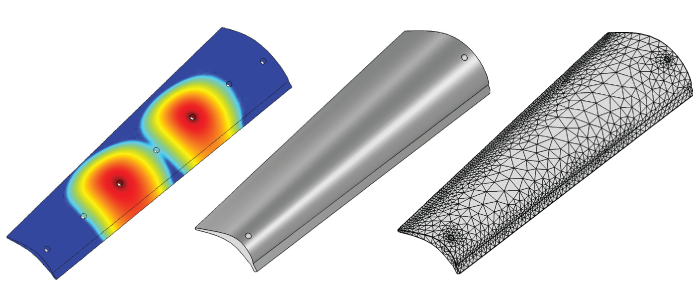Above: Visualizations of an aircraft rotor made of ceramic-matrix composites. The CMCs will replace parts within next-generation engines to provide improved thrust and fuel efficiency.
Aviation industry manufacturers have traditionally relied upon conventional metals and alloys for constructing internal engine parts. During operation, these engines can generate sufficient heat to raise temperatures to within 50 degrees of the melting point of the nickel-based superalloys, titanium, aluminum and steel used in engine construction.
Next generation engines are being designed with increased power density to offer improved thrust and fuel efficiency, as well as reduced emissions. Operating temperatures approaching 2000° F are forecast for these design, thus requiring the use of new ceramic components that can withstand the severe environment.
When compared to metals, however, ceramics exhibit a relatively low resistance to fracture, a property that has restricted their extensive use in high-stress structural elements, such as turbines. To address this challenge, significant research has focused on the development of ceramic-matrix composites (CMCs), which fuse together a ceramic matrix and ceramic fibers to increase structural durability without losing high-temperature capabilities. Yet, the complexity of the manufacturing process for CMCs has precluded the routine, cost-effective manufacture of different components, shapes and materials.
“These barriers can be significantly reduced by using predictive computational design tools,” said Jeffrey Crompton of AltaSim Technologies, a design and engineering firm that has developed a predictive computational modeling and simulation design tool for the CMC manufacturing process. “The range of physical phenomena that must be incorporated is large and the interactions that occur between them is complex; consequently no routine commercial simulation tool is currently available.”
The design tool requires advanced computer software and HPC-based hardware, thus making it difficult for many practicing manufacturing engineers to use on a routine basis. Therefore, AltaSim engineers now are developing an online “manufacturing app” version of the tool in collaboration with the AweSim industrial outreach initiative at the Ohio Supercomputer Center. AltaSim also is expanding its existing CMC manufacturing design tool to reach applications in the automotive and chemical processing industries.
“To extend the commercial benefits of using CMCs to other industry sectors means that the design tool must be made readily available to the broader base of small and medium-sized businesses who routinely service the automotive and chemical processing industries,” said Crompton. “This requires optimization of the design tool to meet the specific challenges of these industries and the development of intelligent interfaces around a common framework to allow non-expert users access to turn-key HPC based application solutions.”
Project Lead: Jeff Crompton, Ph.D., AltaSim Technologies
Research Title: Ceramic-matrix composite manufacturing technology
Funding Source: Department of Energy
Website: http://www.altasimtechnologies.com/advanced-materials/ceramic-matrix-com...

